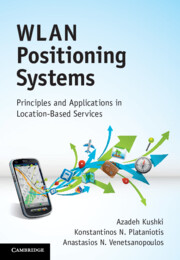8 - Sensor selection
from Part II - Signal processing theory
Published online by Cambridge University Press: 05 February 2012
Summary
Positioning systems employ information from a large number of access points and anchor points distributed over large areas to locate a mobile device. In order to form a position estimate, the system must combine or fuse the information provided by these sources to make inferences regarding the location of a mobile device. Fusion of data from multiple sources is not a trivial task as redundancy and conflict among the information can significantly affect the accuracy and reliability of the final estimate. In the context of positioning, data fusion is especially challenging as the unreliable and time-varying nature of the radio-propagation channel means that erroneous and out-of-date information may be received from access and anchor points. In this Chapter, we focus on one data fusion challenge, namely sensor selection. In our context, sensor selection refers to selecting a subset of the available access and anchor points for positioning.
The rest of this chapter is organized as follows. We begin by motivating sensor selection for WLAN-based positioning (Section 8.1). We then proceed to discuss several methods for access point and anchor point selection (Sections 8.2 and 8.3). We conclude this chapter by illustrating the benefits of sensor selection using experimental data (Section 8.4).
Motivation
In WLAN-positioning, information from multiple anchor points and access points is fused to form a position estimate. Careful selection of the sensors that contribute to positioning can benefit RSS-based positioning in two ways.
- Type
- Chapter
- Information
- WLAN Positioning SystemsPrinciples and Applications in Location-Based Services, pp. 113 - 126Publisher: Cambridge University PressPrint publication year: 2012



